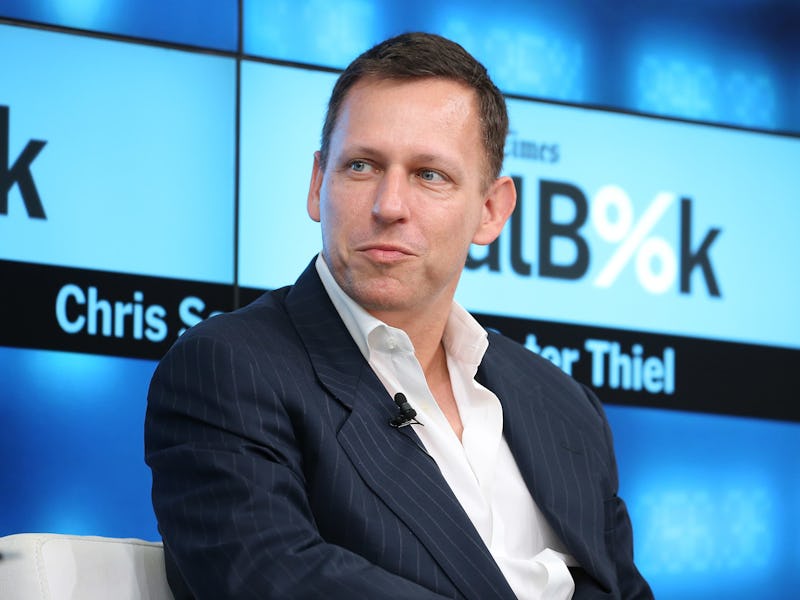Weird Science Projects Funded by Peter Thiel's Breakout Labs Ranked by Ambition
Silicon Valley's most vengeful investor does much more than attack publications.

If you didn’t know the name Peter Thiel before this week, you probably do now. The prominent PayPal cofounder just received a tsunami of ink after outing himself as the money behind Hulk Hogan’s lawsuit against Gawker only a few days after being identified as a Trump delegate.
When he’s not busy keeping professional wrestlers’ sex tapes private or attempting to build a libertarian utopia on the high seas, Thiel cuts checks for Breakout Labs, an incubator for science startups. The business specializes in funding researchers working at the sharpest part of the cutting edge, scientists who might otherwise struggle to secure funding. The 18 projects currently financed under the Breakout umbrella are a grab-bag of ambition and overreach, which make the San Francisco operation one of the most interesting (and overlooked) incubators in the Bay Area.
To give the best possible sense of what Thiel seems to be attempting to achieve, we’ve ranked his science projects from least to most ambitious. Things get pretty real around number 11.
18. Maxterial
A team in San Pablo, CA, is testing “superhydrophobic metallic coatings” to make material surfaces more resistant to damage and environmental degradation. The applications across technology are pretty clear.
17. C2Sense
This project in Cambridge, MA, could potentially eliminate food waste by detecting chemical compounds that indicate ripeness. The hope is to create products that help consumers identify fresh produce and, thereby, avoid the disposal of edibles, which has a direct economic cost of roughly $750 billion per year (depending on how you look at it).
16. Ion Dx
Ion Dx wants to revolutionize the way we measure protein conformation. It could impact a variety of medical therapies including in-vitro diagnostics.
15. Seatrec
Run out of Pasadena, CA, Seatrec is a renewable energy company that could make hazardous lithium batteries obsolete. The Seatrec Thermal Recharging Battery extracts energy from ocean temperature gradients, providing thermocline power to underwater robots.
Longevity Biotech wants to develop therapies based around Hybridtides, which are molecules resistant to natural digestive enzymes because they contain both α- and β-amino acids.
Funded by Breakout Labs since 2012 and run out of Boulder, CO, this company hopes to create gold nanorods that could aid in the application of cancer therapies.
12. Entopsis
Life-changing diagnoses while you wait! This Miami-based project wants to analyze any kind of protein or cell sample in less than one hour.
11. General Genomics
Lest you thought gout research was being neglected, know that Atlanta-based General Genomics is working to develop more efficient protein- and peptide-based therapies to treat diseases treatable with a salad.
10. E3XBio
Working from Menlo Park, CA, this team is focusing on a specific class of enzymes, E3 Ubiquitin ligases, to target a range of diseases. This class of medically relevant enzymes is considered an important target for diseases ranging from cancer to neurodegeneration, but has been inaccessible to high-throughput drug screening because the current assays are cumbersome, indirect, and rely on a complex reaction mixture than can be complicated by multiple protein activities. E3X Bio’s streamlined screening paradigm and direct cellular and animal model assays, allow a simplified, pragmatic drug discovery approach.
9. G-Tech
A team in Palo Alto, CA, is building a wearable, disposable patch it’s calling “an EKG for the gut,” which will purportedly be able to diagnose and/or rule out various diseases in its wearers.
8. Neumitra
Whether we want to admit it or not, most of us would be interested in a tool that would let us quantify our stress. Neumitra seeks to embed biomodules in the body to read signals from the autonomic nervous system and track our reaction to the slings and arrows of outrageous fortune.
Working out of Emeryville, CA, and funded by BreakoutLabs since 2013, this team is in the business of building new molecules. The short term focus is on fragrances and cosmetics, but the long term goals are industrial and won’t smell as nice.
6. nanoGriptech
Remember that Mission Impossible stunt where Tom Cruise goes running around the outside of the Burj Khalifa after climbing the thing using special sticky gloves that turn him into a human gecko? Basically, nanoGriptech is creating that tech IRL using microhairs that creating intermolecular attractions, allowing for adhesion without adhesives.
This project, run out of Livermore, CA, wants to use a class of elementary particles known as positrons to explore energy-antimatter propulsion. (Yes, the sort of propulsion that could make deep space travel possible.)
4. AVEtec
This Ontario-based project, funded by Breakout Labs since 2012, involves literally building a tornado in an attempt to harness its energy. The “vortex” in question will by two feet wide and 200 feet tall and capable of make turbines spin like tops.
3. EpiBone
Launched in New York in 2014, this project uses stem cells in an attempt to replace synthetic bone implants. If successful, this technology would allow patient-specific bones to be grown before surgery. Columbia Professor Gordana Vunjak-Novakovic is pioneering this technology based on the last 15 years of bone tissue engineering research the NIH has funded.
This Mountain View, CA, cryopreservation operation claims its cooling technology already has applications for organ donation and grafting. Combined with stem cell therapies and new tissue engineering technologies, Arigos could offer the doctors the ability to bank organs as well as blood.
1. CyteGen
This Madison, WI, project doesn’t come right out and say it wants to end the aging process, but it comes very close by targeting “age-related decline” and age-associated diseases such as Multiple Sclerosis and Parkinson’s. Not only that, CyteGen explicitly says that decline can be reversed through the improvement of cellular metabolism. That means it’s not just about staying young, it’s about getting younger.
Apparently Thiel doesn’t plan to go softly.